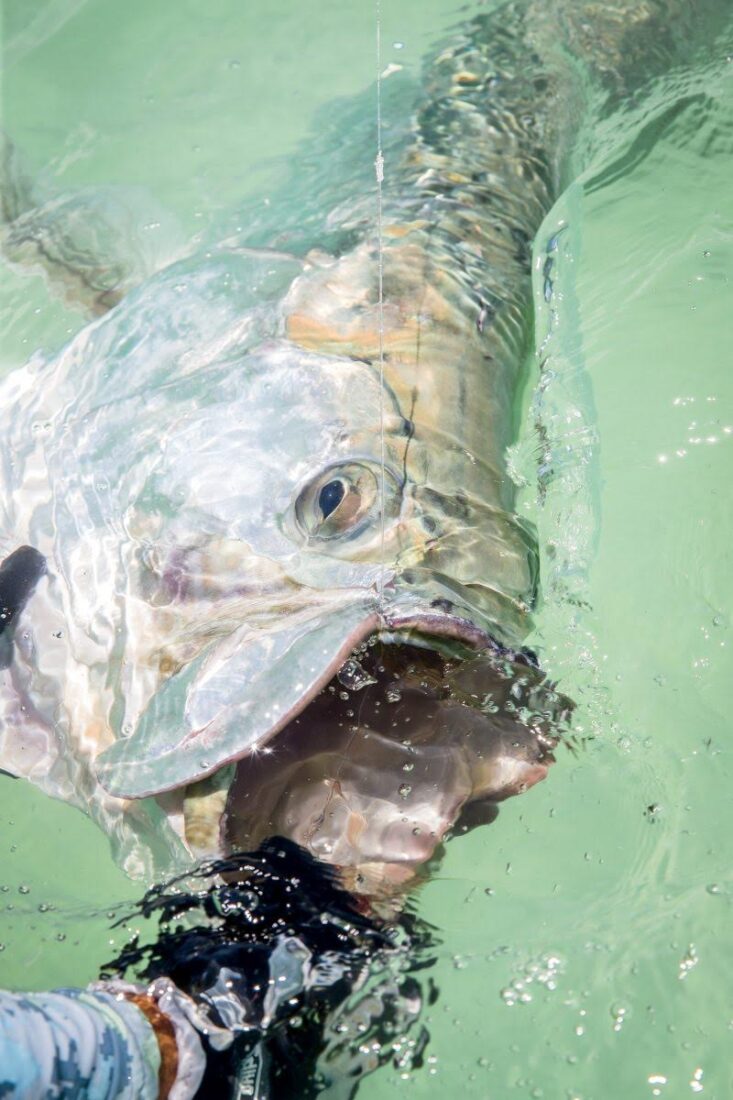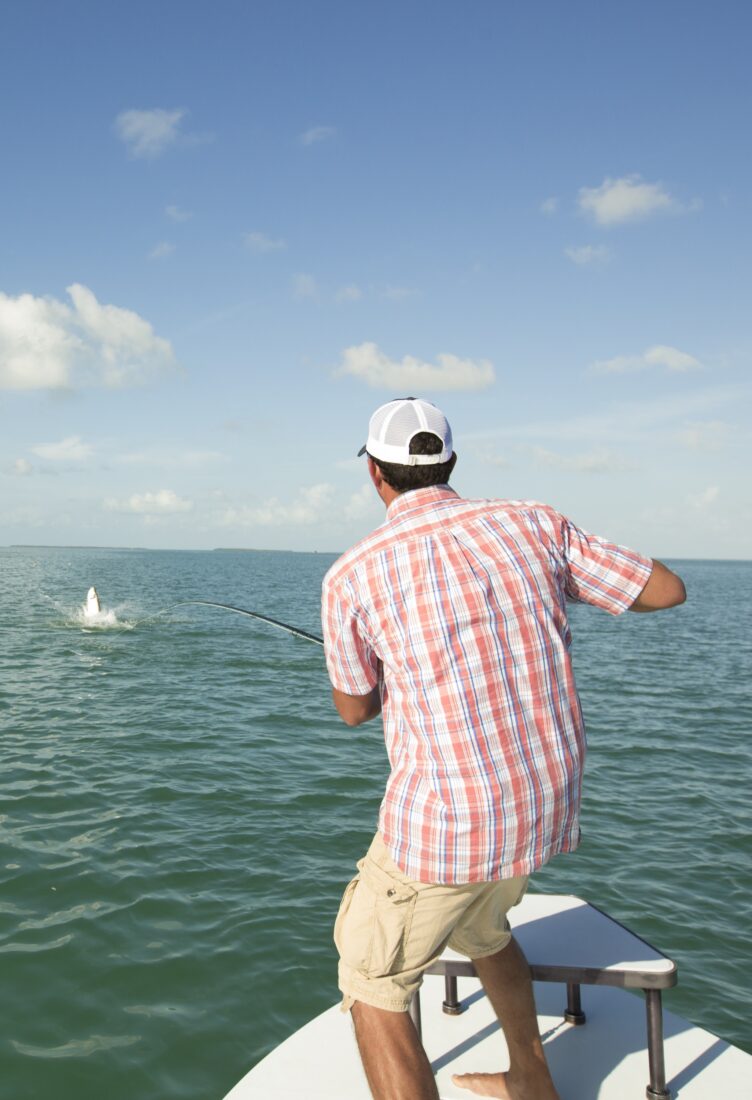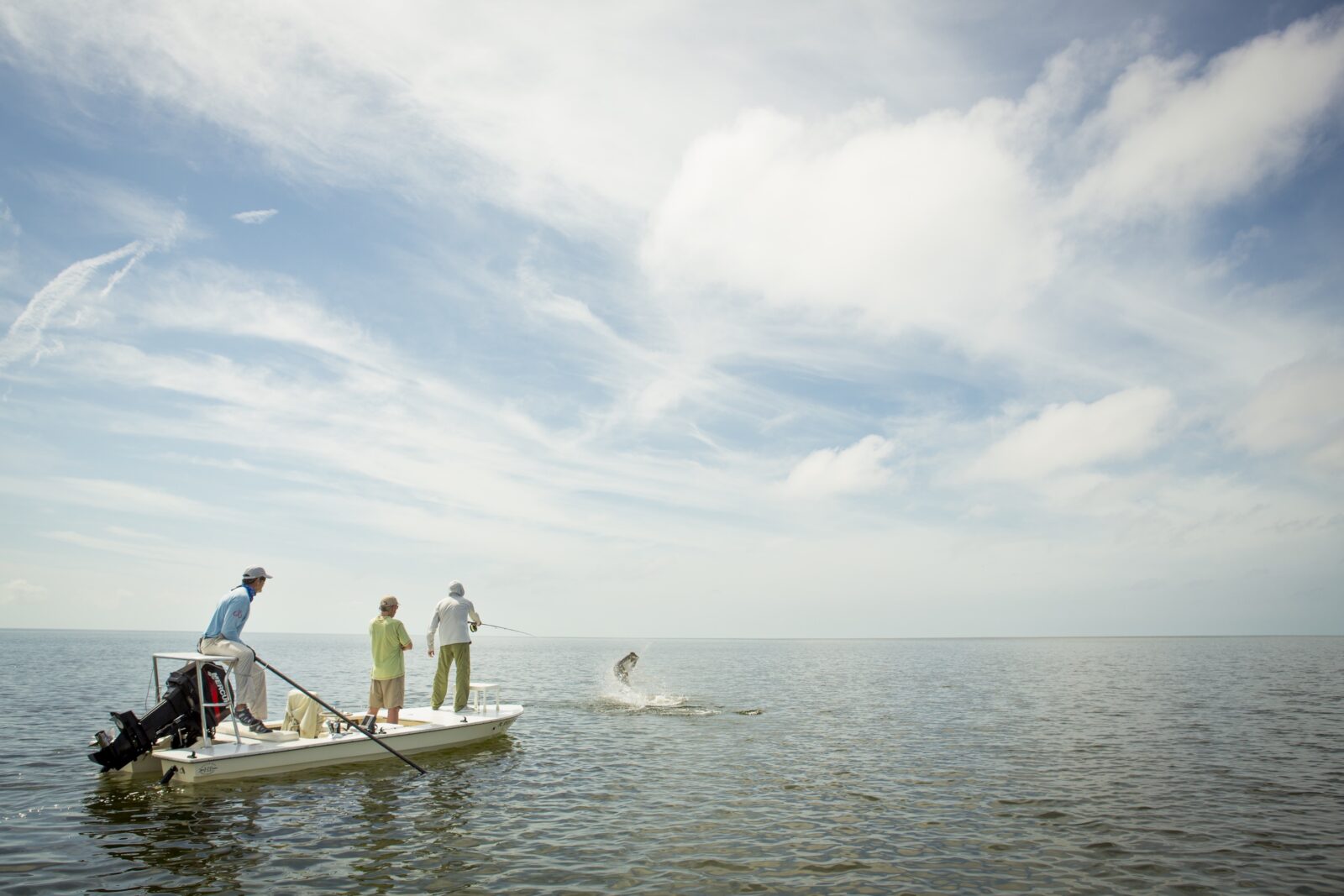Land & Conservation
There’s been a noticeable decline of the species in Florida Bay and the Keys. A look at why—and what we can do to reverse the trend
By Monte Burke
April 5, 2023
Every spring, tens of thousands of tarpon make their way from the deepest part of the ocean to the shallow flats of the Florida Keys as they embark on their spawning run. There, they connect with another migration, this one comprised of legions of anglers from all over the world who flock to the Keys—clogging up the lone strip of highway, filling motels and restaurants and helping to generate an estimated $465 million annually for the region—in the hopes of catching a tarpon which, because of its size (up to seven feet long and more than 200 pounds), power (like an 18-wheeler in the fast lane) and beauty (silver scales that glint in the sun as if polished), is among the most prized gamefish on the planet. I will be among those highway-clogging tarpon seekers, as I have been for the better part of the past fifteen years.
In recent years, though, we migrating anglers have been witness to a disturbing trend: fewer tarpon, particularly in Florida Bay (located between the mainland and the Keys) and southernmost part of the Keys. And fishing guides—the canaries in the coal mines when it comes to gamefish resources—have begun to sound the alarm about a species that appears to be under duress. “The tarpon just don’t show up in their normal areas like they used to,” says Ted Wilson, who has been guiding out of Islamorada for twenty-eight years. In the middle portion of the Keys, Albert Ponzoa, a guide in Marathon, says: “There’s a big body of fish missing and we can’t find them.” Further south in Key West, guide Don Gable, echoes the sentiment: “Something happened about six years ago, some change to the fishery, where the fish just disappeared,” he says. “And if we continue on the rate we’re on, I think we’re going to lose the fishery completely.”

An eighty-pound tarpon at boatside.
So where have all the tarpon gone?
The first answer is, at once, the most obvious and most disheartening: Tarpon are a species in decline. “There is no doubt that there are fewer tarpon now than there were fifty years ago,” says Aaron Adams, the director of science and conservation at the Bonefish & Tarpon Trust. What guides and anglers are witnessing on the water is backed up by some empirical evidence. Though tarpon are not a commercially harvested species in the United States—and thus lack any quantitative population assessment data in this country—they are harvested in other parts of their Atlantic Ocean range, like Brazil and Venezuela. And that harvest data indicate enough of a decline that the International Union for Conservation of Nature—a United Nations-affiliated group comprised of more than 1,400 governmental and non-governmental agencies—has placed tarpon on its “red list” of threatened species.
The second is that tarpon appear to have altered their migratory patterns. While there may be fewer fish in Florida Bay, tarpon now show up in larger numbers—and for longer durations—than ever before off the coasts in places like Georgia, South Carolina, and Virginia.
Both the population decline and the change in migratory patterns have the same root cause: us.
Commercial harvest of tarpon in other countries certainly plays a role in the decline. But poor recreational fishing practices in this country do as well. Tarpon are a catch-and-release species in Florida (save for the miniscule number of potential record fish that are killed each year), but released fish can, and sometimes do, die. Prolonged, drawn-out fights on a fly rod or conventional tackle can kill them. So can sharks. In the Boca Grande Pass—a pre-spawning staging area for tens of thousands of tarpon—fatal shark attacks on weakened released fish are fairly routine, sometimes numbering in the dozens per day (which adds up during the roughly five-month tarpon season there). And according to several guides, shark attacks on tarpon around the bridges in the Keys—where tarpon congregate on certain tides—have increased dramatically in recent years.
The loss of these mature fish can be devastating to a species like tarpon, which live long lives (up to eighty years) and take roughly ten years to become sexually mature. It also lengthens the potential recovery time for the species. But mature fish are not the only ones being lost. Because of unchecked development and pollution, South Florida’s coastal mangrove forests have become severely diminished (according to NOAA, the Keys have lost sixty percent of their mangroves to development since the 1950s). Mangroves, critical to the overall ecosystem (and as hurricane buffers), are where juvenile tarpon are reared. “Losing half of the habitat capacity for juvenile tarpon is a disaster for the species,” Adams says.
Other types of habitat degradation—in particular, water quantity and quality—likely also play a role in the changed migratory behavior of tarpon. Florida Bay—which receives only one-third of its historical freshwater flow from the Everglades—has been plagued by algae blooms. Nitrate-based toxic algae in Lake Okeechobee is periodically and disastrously flushed out to both coasts, causing massive red tides. (There is currently a red tide in southwest Florida that is causing fish kills.) Increased boat traffic in the Keys “backcountry”—mainly from partygoers—has wreaked havoc on fishing areas, in specific, and ecologically sensitive areas, in general. Overlaying all of this, of course, is climate change. Rising water temperatures and sea levels exacerbate all of Florida’s other ecological problems. A healthy ecosystem is more resilient in the face of climate change. An unhealthy one is not.

Tarpon, as a species, have proved to be highly adaptable, surviving ice ages, extreme heat and extinction events in their fifty million years on earth. To paraphrase Richard Powers in The Overstory, his great novel about trees, this is not our world with tarpon in it. It’s the tarpon’s world, and we—who’ve been around for a mere 300,000 years—have just arrived. And yet it may be the Anthropocene—as many scientists have begun to call this geological age, one in which humans are the major influences on earth and its environment—that is its biggest test.
Though we are clearly the biggest single cause of the problems tarpon face, we are also the possible solution. But there is no silver bullet, Adams warns. “We didn’t get into this problem overnight and we won’t get out of it that fast, either,” he says. It’s hard for us, as individuals, to truly believe that we have any control over some of our bigger environmental challenges, like global warming, which is almost so large of a problem that it’s feels ungraspable. There are, however, some steps we can take that are within our grasp. We recreational anglers can better police ourselves, and refrain from long fights and from fishing for tarpon when sharks are present in the Boca Grande Pass, or around the Keys bridges or anywhere else. Dedicated traffic lanes for non-fishing boats, especially in the various National Wildlife Refuges in the Keys backcountry, would solve some of the problem, too. “They don’t let Jeeps drive all over Yellowstone,” says Andrew Tipler, a guide in the lower Keys.
And, maybe most important, those of us who like to fish for tarpon in Florida need to get involved in their wellbeing. Vote out the politicians who push rampant and irresponsible development (more than forty percent of Florida’s state lawmakers have direct ties to real estate, according to the Daytona Beach News-Journal). Join and support conservation and watchdog groups (see below for suggestions). “People are really nervous about the fish,” says Tipler. Tarpon are clearly telling us something is wrong. It’s time to listen, because their decline may be a harbinger of worse things to come.
Here are some groups involved in tarpon conservation:
Monte Burke is the author of Lords of the Fly: Madness, Obsession and the Hunt for the World-Record Tarpon

